Searching for an alternative to sushi rice? The secret to delicious sushi lies in flavorful rice that sticks together well. Mimicking traditional Japanese rice's unique flavor and texture will take your healthy homemade meal to the next level.
Below, we've rounded up seventeen of the best sushi rice substitutes. We've got something for every dietary need— whether you're looking for a low-carb option, increasing your vegetable intake, or simply running out of white rice.
What Is Sushi Rice?
Before breaking down the best substitutes for sushi rice, let's first look at what makes sushi rice so different. The key to successfully swapping in different rice types is to recreate the sticky texture and unique flavor closely. Without it, your meal won't taste the same— even doused in soy sauce and topped with a mountain of wasabi and ginger.
What type of rice is sushi rice? Is sushi rice the same as regular rice? Chances are you've asked yourself these questions at some point or another while digging into your favorite sushi rolls. Typically, sushi rice is made using short-grain Japanese rice, and its high starch content creates a sticky texture that helps hold the rice together during rolling.
Another key to making sushi rice— whether with classic short-grain rice, whole-wheat couscous, or keto cauliflower rice— is adding the proper seasonings: rice vinegar, salt, and sugar. Regardless of which sushi rice alternative you're using, you'll want to add a splash of rice vinegar to give it that traditional umami flavor.
17 Sushi Rice Substitutes
Long-Grain Rice
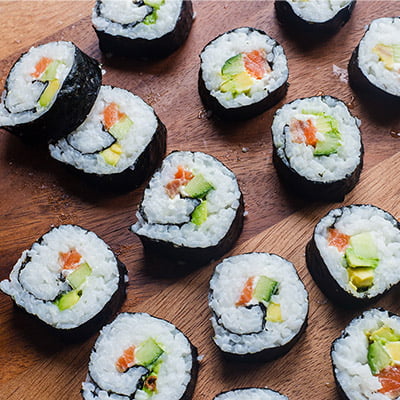
Don't have short-grain white rice on hand? No problem! Long-grain white rice is one of the easiest sushi rice alternatives out there. Be sure to cook the rice thoroughly to help create that soft, sticky texture you're looking for. Any white rice you have on hand will do just fine. But if you're looking for something more unique or more nutritious, try the other alternatives below.
Pudding Rice
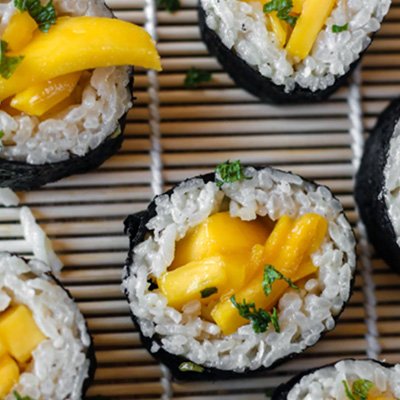
If you have any sort of rice or brown rice on hand, you can make milk rice, or some refer to this as pudding rice. Instead of cooking rice with rice vinegar and water, it is cooked with milk, coconut milk, or other types of milk. This method makes great rice that works in many dishes, including risotto, sticky rice, and rice pudding.
Unlike the other rice variety, the pudding rice option gives the rice a sweeter taste with a milky flavor. Besides being tasty, it also provides a sticky texture, making it a great substitute for sushi rice. While it can be used as a substitute in a pinch, it may not provide the same desired characteristics as sushi rice.
Risotto Rice
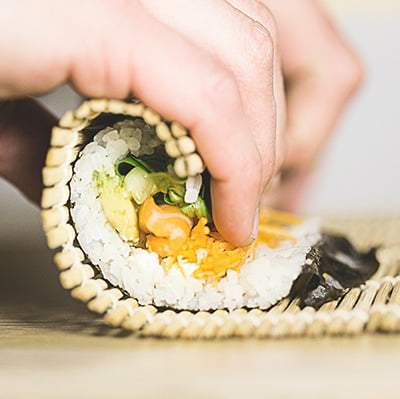
Risotto rice, or Arborio rice, is short-grain rice with a high starch content that works great for sushi. The short-grain white rice is best known for its role in risotto, a deliciously creamy Italian rice dish.
Arborio rice has a creamy and slightly chewy texture when cooked, which is different from the firm and slightly sticky texture of sushi rice. The grains are plump and rounded, specifically crafted to absorb liquids and release starch while cooking. Though risotto rice tends to turn a bit chalky, with a little salt, vinegar, and sugar, it'll taste just as good as the real thing.
Brown Rice
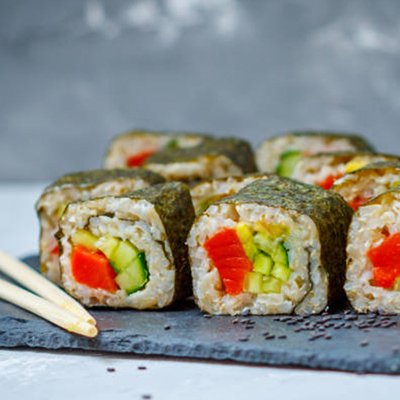
Substituting sushi rice for brown rice is a great way to increase your whole grain intake, and brown rice offers so much healthy nutrition. Choose brown sushi rice if you have diabetes since it has the lowest GI. For these reasons, many rice consumers are converting to eating brown rice.
These days, many Japanese restaurants offer brown rice sushi on their menus to appease healthy eaters. While it won't have exactly the same consistency or flavor, the proper preparation can create something similar.
First, you'll want to soak the brown rice for a few hours before cooking. Use brown rice cookers or rice cookers in brown rice settings to ensure the chewy grains are thoroughly cooked. Add an extra splash or two of rice vinegar to balance the flavors and help hold the rice together as you roll.
Quinoa
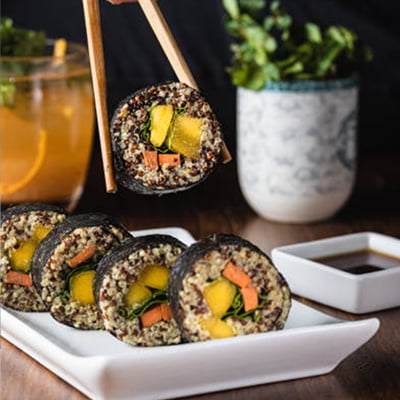
Although quinoa is technically a seed, it is commonly used as a substitute for grains. Packed with nutrients, quinoa makes a healthy option for vegetarian sushi rolls. It's a complete protein that's loaded with fiber, amino acids, and iron. Another perk: quinoa is naturally gluten-free.
Quinoa has a slightly nutty flavor and a light, fluffy texture that is slightly chewy, so you'll want to cook it for a few extra minutes and add a little extra sugar to get that soft, sticky texture. In addition to sushi rolls, quinoa can be used to make other traditional Japanese dishes like onigiri, oyakodon, and chirashizushi a bit healthier too.
Cauliflower Sushi Rice
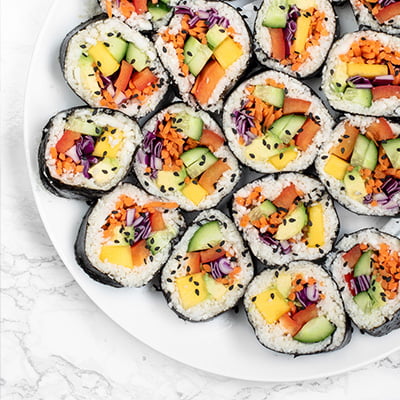
Cauliflower rice is a fantastic sushi rice option if you're eating a keto or low-carb diet. Made by finely grating or processing cauliflower florets, cauliflower rice is a low-carb and nutritious substitute for sushi rice. With a texture resembling that of rice, quinoa can be used as a versatile ingredient in a wide range of dishes.
While you can make your own cauliflower rice in a food processor, starting with a bag of cooked cauliflower crumbs is easiest. You can saute the cauliflower in coconut oil or olive oil for a few minutes and let it cool. Because cauliflower contains less starch than white rice, your vegetable sushi rice will be far less sticky. Roll your seaweed wraps or rice wraps carefully, and cut your roll into larger pieces that'll hold together.
Forbidden Rice
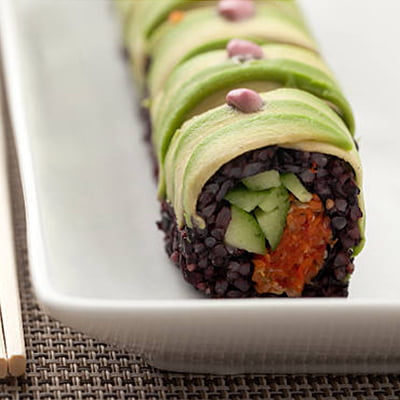
Don't let the name fool you. There's nothing wrong with using forbidden rice for sushi; it binds almost as well as any other short-grain rice. But note forbidden rice has a bit of natural sweetness, so skip the sugar during seasoning.
Also known as black rice, this nutty, nutrient-rich grain is similar to brown rice, and you can cook it the same way you would cook sushi rice. It's packed with antioxidants, fiber, and protein that make for a filling (and not to mention delicious) meal. It is also known to help keep blood sugar and cholesterol under control. Plus, it'll add a unique black color to your sushi roll that's impossible to keep off the 'Gram.
Red Rice
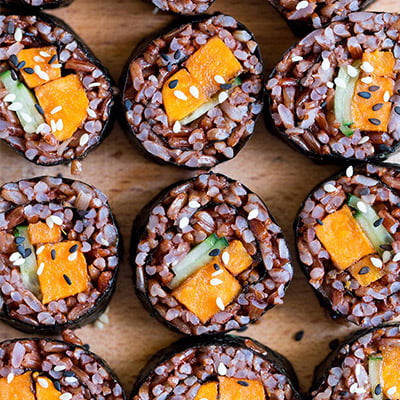
Red rice provides many healthy nutrients, like brown rice and black rice, and is one of the best sushi rice alternatives. Red rice, characterized by its reddish-brown husk, is a whole-grain rice variety that boasts a delightful nutty flavor. Some sushi chefs will even use red rice during holidays or celebrations. While this type of rice takes longer to cook and less stick than sushi rice, they do add extra nutty flavor and texture.
Red rice has a firm and slightly chewy texture when cooked, making it different from sushi rice's soft and slightly sticky texture. It's important to note that using red rice as a sushi rice substitute will result in a different texture and flavor experience. Red rice's nutty flavor and firm texture can add a unique element to your sushi-inspired dishes.
Couscous
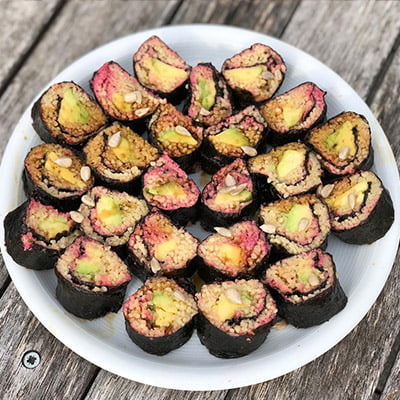
Though couscous isn't technically rice, it can still be used in a pinch to replace sushi rice. Couscous is a North African dish that's closely related to pasta. The small rice-like balls are semolina flour made from durum wheat, and its high gluten content actually helps create a sticky, rice-like texture— especially with a sprinkle of sugar and a splash of sushi vinegar.
Using couscous as a sushi rice substitute can provide an interesting twist to your sushi rolls. While it may not replicate traditional sushi rice's exact texture and stickiness, couscous can still be a flavorful and versatile option.
Sticky rice
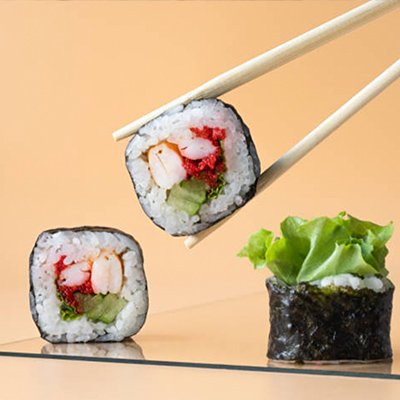
Sticky rice, also known as "sweet rice," tastes sweeter than regular white rice and other rice types, making this rice a better option for dessert. But, because this type of rice is sticky in nature due to its naturally high starch content, it makes it one of the best sushi rice substitutes.
It's important to note that using sticky rice as a sushi rice substitute will result in a significantly different experience than traditional sushi. The stickiness and chewiness of sticky rice may require some adjustment in rolling techniques and flavors.
Bulgur
Bulgur, a grain derived from cracked wheat, is a staple ingredient in Middle Eastern and Mediterranean cuisines. Using bulgur as a sushi rice substitute can create a nutritious and hearty twist to your sushi rolls. Bulgur has a chewy and slightly nutty texture, which can add a unique element to your sushi rolls. It provides a rich and earthy flavor that pairs well with various fillings.
Lentils
Using lentils as a sushi rice substitute is an unconventional choice but can offer a nutritious and flavorful twist to your sushi rolls. Lentils, a type of legume, exhibit a wide range of colors, including green, brown, red, and black.
Lentils have a soft yet slightly firm texture when cooked, and they provide a hearty and earthy flavor that can add depth to your sushi rolls. Once the lentils are cooked, seasoned, and cooled, you can use them as a base for your sushi rolls. Lentils have a different texture and flavor than traditional sushi rice, and the soft yet slightly firm texture of lentils can provide a unique mouthfeel to your sushi rolls.
Shirataki Rice
Using Shirataki Rice as a sushi rice substitute is another option, particularly for those following a low-carb or keto diet or looking for a gluten-free alternative. Shirataki rice, crafted from konjac yam, is exceptionally low in calories and carbohydrates. It has a gelatinous texture and virtually no flavor, making it a good option for those watching their calorie intake. It is also a good sushi rice substitute for making keto-friendly sushi rolls.
It's important to note that Shirataki Rice has a distinct gelatinous texture that may differ from traditional sushi rice. Some people enjoy this texture, while others may get used to it. If you're looking for a low-carb or gluten-free alternative, Shirataki Rice can be a viable option to explore.
Wild Rice
Although not true rice, wild rice is a grass seed with a chewy texture and a nutty flavor. Using wild rice as a sushi rice substitute can add a unique and nutty flavor to your sushi rolls. While it may not provide the exact texture of traditional sushi rice, it can be an interesting alternative.
Wild rice has a firm and chewy texture with a nutty flavor. It consists of dark, long-grain rice that can add a visually appealing element to your sushi rolls. It's important to note that wild rice has a distinct texture and flavor that may differ from regular sushi rice. The chewy texture and nutty taste can uniquely twist your sushi rolls.
Millet
Using millet as a sushi rice substitute is an interesting and nutritious option, especially for those who follow a gluten-free or grain-free diet. Millet has a slightly sweet and nutty flavor with a delicate texture. When cooked, it becomes fluffy and tender, but it doesn't have the same stickiness as traditional sushi rice. Nevertheless, it can be utilized with success in sushi rolls.
It's worth noting that using millet as a sushi rice substitute will result in a slightly different texture and taste compared to traditional sushi. However, it can serve as a wholesome and flavorful substitute, particularly suitable for those seeking gluten-free or grain-free alternatives.
Bomba rice
Bomba rice, or Valencia rice, is a short-grain rice variety known for absorbing flavors while maintaining its shape and texture. While it may not provide the exact characteristics of sushi rice, it can still be used creatively.
Bomba rice has a firm and slightly chewy texture when cooked, and it has the ability to absorb liquids while retaining its shape, making it suitable for dishes like paella. However, the texture is different from the soft and slightly sticky texture of sushi rice.
Due to its firmer texture, Bomba rice may not hold its shape well for rolling traditional sushi rolls. Instead, you may consider using Bomba rice creatively for sushi-inspired dishes. For example, you can use it as a base for rice bowls or as a filling for onigiri (rice balls) by shaping small portions of rice around fillings of your choice.
Carnaroli Rice
Carnaroli rice, predominantly featured in Italian cuisine, is particularly prized for its role in crafting creamy risotto. This medium-grain rice variety possesses a high starch content, resulting in a luscious texture when cooked. While it may not provide the same stickiness as sushi rice, it can still be used creatively for sushi-like dishes.
Unlike arborio rice, carnaroli rice contains more starch and is firmer. Carnaroli rice has a creamy and slightly chewy texture when cooked, which is different from sushi rice's firm and slightly sticky texture. The grains retain their shape well and have a satisfying bite. The creamy texture and ability to absorb flavors can add a unique element to your sushi-inspired dishes.
